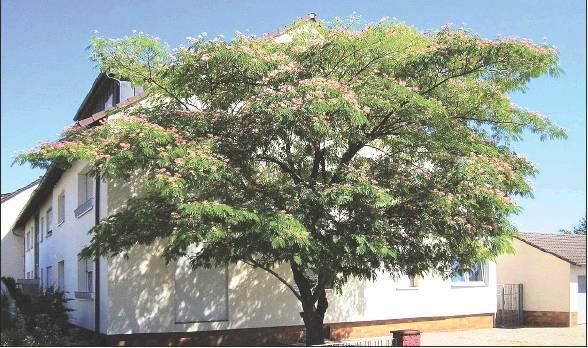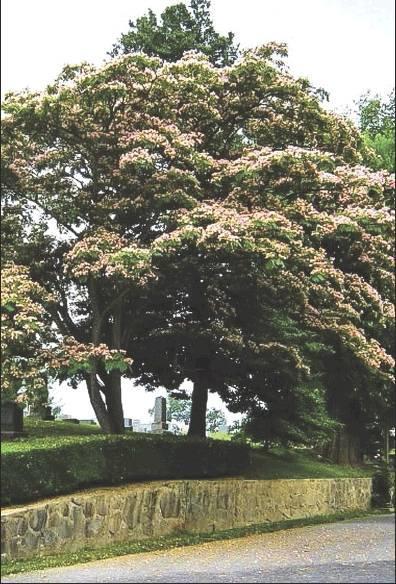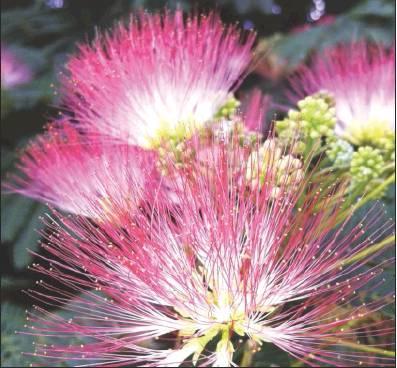Getting into Gardening
The mimosa tree, sometimes called the Persian silk tree, is a legume that can help enrich the soil where it grows. It is a deciduous tree that grows from 10 to 50 feet tall. It can have one or more trunks and the canopy is shaped like an umbrella. The bark is light brown to gray and have lenticles that look like corky dots. The wood is weak and brittle, with doubly compound leaves thay alternate on the stem. The leaves are 6 to 20 inches in length and are almost fern-like and feathery in appearance. The sweetly fragrant light to dark pink, flowers are showy and wispy; and one of the major reasons for its importation as an ornamental plant. The Persian name means “night sleeper,” and in Japan it is known as the sleeping tree. That is because the bipinnate leaves fold up at night and during rainstorms.
Bipinnate simply means that instead of having undivided leaves, the leaves are separated like those of a fern or a palm frond. The flowers are anywhere from pale to deep pink and form in clusters that look like fine silk threads. They form long pods that are 5-7 inches long and enclose the seeds.
The mimosa tree, known by the scientific name Albizia julibrissin, is native to eastern and southwestern Asia, and does so well in most climates here in the United States that many states, such as Florida, consider it invasive. It is a fast-growing ornamental tree that can reach up to 30 feet or slightly more in height.
While these trees are beautiful and powerful, their effect on the natural environment can be problematic outside of their natural ecosystem. The wide environmental tolerance of the silk tree allows it to outcompete a wide variety of native trees and shrubs in disturbed areas. Also, because it can grow in several types of soil, reproduce profusely and re-sprout after damage it has a significant advantage over other plants. By reproducing quickly, mimosa trees can form in dense stands that shade out native plants and deprive them of nutrients from the soil. The severity of their impact is debatable, but, as environments shift, it’s becoming more and more important to study these trees.
The mimosa tree handles our hottest weather just fine but is also cold weather tolerant and has been known to survive temperatures as cold as -25 degrees Fahrenheit. My friends at the Nature Hills Nursery in Omaha Nebraska claim the mimosa tree “acts as a natural de-wormer for woodland creatures.”
From my own experience, in addition to being pretty and smelling wonderful, the mimosa trees that have been in my yard provided lots of great shade from the hot summer sun, and I just love them. Unfortunately, the mimosa tree is considered by many horticulturalists, and others, to be an ecological threat. As I stated above, it can grow in a variety of soils, produce large seed crops that travel and spread easily by wind and water, and re-sprout when damaged.
The mimosa, I am told, is a strong competitor to native trees and shrubs in open areas or forest edges. Dense stands of mimosa can severely reduce the sunlight and nutrients available for other plants.
That having been said, I must honestly confess, that as prevalent as mimosa trees are here in our part of Texas, I have never seen a “dense stand” of them anywhere, nor have they ever gotten out of control that I know of. I have never heard anyone complain about them in that way.
Texans do complain about mimosa trees, but the complaint is about the messiness of Mimosa not its invasiveness. The tree sheds in multiple stages; blossoms, followed by seedpods, then leaves, then sticks, which are either leaf petioles or twigs. The sticky, staining, brown paste formed by wet dropped blossoms is particularly noxious. Plants underneath a Mimosa can become coated and disintegrate under a thick carpet of brown flower goop. Positioning a Mimosa over a walkway or driveway may not be prudent. Mimosa also messily self-sows all over the yard.
When growing these beautiful trees on your property, there are several important steps to consider.
First, plant mimosas in a well-draining, sunny site that provides lots of room for it to grow as it grows up to thirty feet tall and thirty feet wide. Water a newly planted mimosa when the soil is dry. Keep doing this until its roots are well established. This should take just one season. Afterwards, water the tree only during droughts. Mimosa will die in soggy soil. Mulching conserves water and increases the time between waterings.
Fertilize mimosa sparingly in spring or not at all. This tree is already a fast grower. Don’t use too much fertilizer. It speeds up growth but can result in weaker branches. Make sure you use a balanced fertilizer, such as 10-10-10. I’d recommend using it at half the rate recommended on the label.
Important note: Mimosas will, most-likely, not last a lifetime. These trees are prone to damage from disease and insects. They will probably grow quickly, reach their peak, then decline and die in about 15 years. These trees bear long seed pods that cling fast, even in winter. Mimosas seed freely, so you’re likely to find new seedlings in your lawn and garden each spring. Most important of all is that you must be mindful of mimosa seeds and seed pods as they are very poisonous. “Beautifully dangerous,” noted Mark Twain when commenting on the mimosa tree. The seedpods are poisonous at all times and the seeds within are even more so.
Do not allow livestock, pets, or especially children to put the seedpods or seeds in their mouths. They can cause seizures and even death. Thoroughly wash hands after handling the seed pods.
Be sure to keep the seed pods away from animals and children. Rake them up as soon as they begin to fall and teach your little ones and all of your children never to put the seedpods in their mouths. Do not assume an older child, or even an adult, who may be unfamiliar with mimosa trees, knows not to do so.
The flowers and leaves are not toxic, and some people cook them and eat them like vegetables. I have made a very nice tea from drying the flowers and leaves, but I always avoid the seedpods and seeds.
If you decide to grow a mimosa tree in your yard I am very much on your side. It grows well in lawns and can make an attractive poolside specimen, though the flower, seedpod and leaf drop make it a bit messy. The canopy makes light dappled shade that is very pleasing. Just plant it well away from your homes foundation as its roots are unbelievably strong and have been seen to crack concrete foundations!






